Home
The Mailjet Blog
Email best practices
Newsletter Marketing Strategy: A Step-by-Step Plan To Drive Traffic
Email best practices
How to plan an effective newsletter strategy
Learn the steps you need to plan and execute an effective newsletter strategy. Discover the top tips on building your email marketing campaigns.
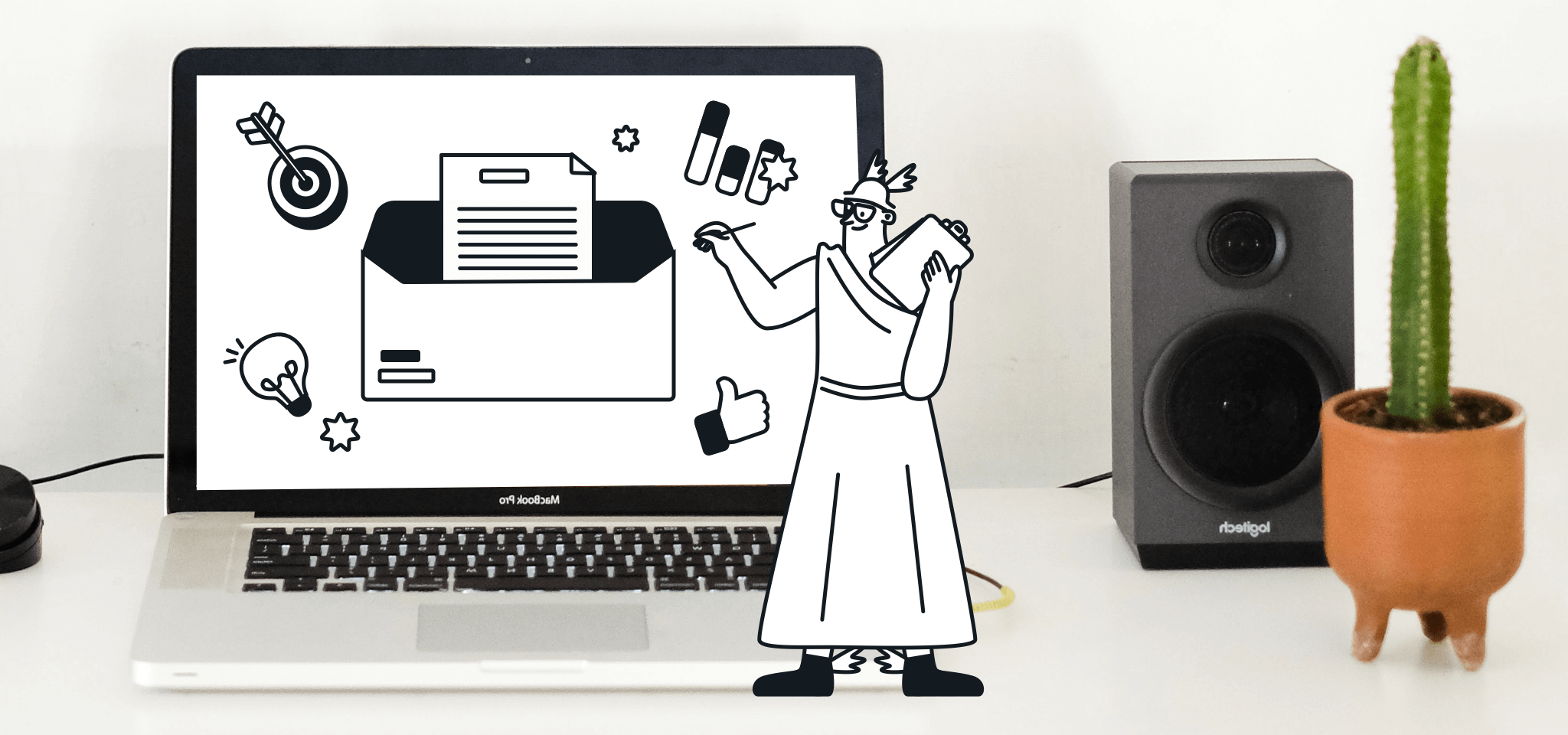
PUBLISHED ON
Newsletters are one of the most important parts of email marketing. Not only do they offer ample space for advertising, but they also help to maintain the relationship between customers and companies.
At first glance, the topic of creating a newsletter may seem to be one of the easiest elements of digital marketing: you open an email platform, write up your text, choose your contact list, and send. Sounds easy, right?
But if you’re looking to really capitalize on your hard-earned contact list, you’re going to need a good understanding of newsletters and to take advantage of newsletter best practices. There’s lots to cover, so we better get started.
Table of content
Constant source of traffic
Considerable savings
Easy performance measurement
Independence from third parties
Easily linked to other online marketing channels
Ability to reach people anywhere and anytime
Tailored customer communications
Absence of physical presence
Ease of deletion
List building takes time
Step 1: Set out your goals
Step 2: Develop your KPIs
Step 3: Find the optimal sending time
Step 5: Choose your newsletter software
Step 6: Build a contact list
Step 7: Creating a newsletter
Step 8: Sending your newsletter
Step 9: Analyzing and optimizing newsletters
What’s a newsletter and why do you need a strategy for it?
Newsletters are one of the oldest forms of digital communication between customers and companies. However, nowadays instead of printing off newsletters and delivering them to mailboxes across the country, companies achieve greater reach through email for a fraction of the cost to the planet and to their marketing budget.
The Data and Marketing Association consistently reports an ROI from email marketing of somewhere between $35 and $40 for every $1 spent, a much higher return compared to other channels such as social media and PPC.
But newsletters are not just exclusive to news. They can contain a diverse range of content like blog posts, podcasts, or product updates. Successful newsletters strike a balance of providing value to the reader while achieving marketing goals.
Instead of taking a “hit and hope” approach to newsletters, having a robust strategy ensures you’re getting the most out of your subscriber base. A strategy first works to keep your subscribers onside by focusing on providing targeted, relevant, and valuable content to your audience. Secondly, a strategy considers the nuts and bolts of email sending, like choosing an email service provider and determining the best time to hit send. Finally, your strategy will establish the business goals and KPIs that determine the success of your marketing efforts.
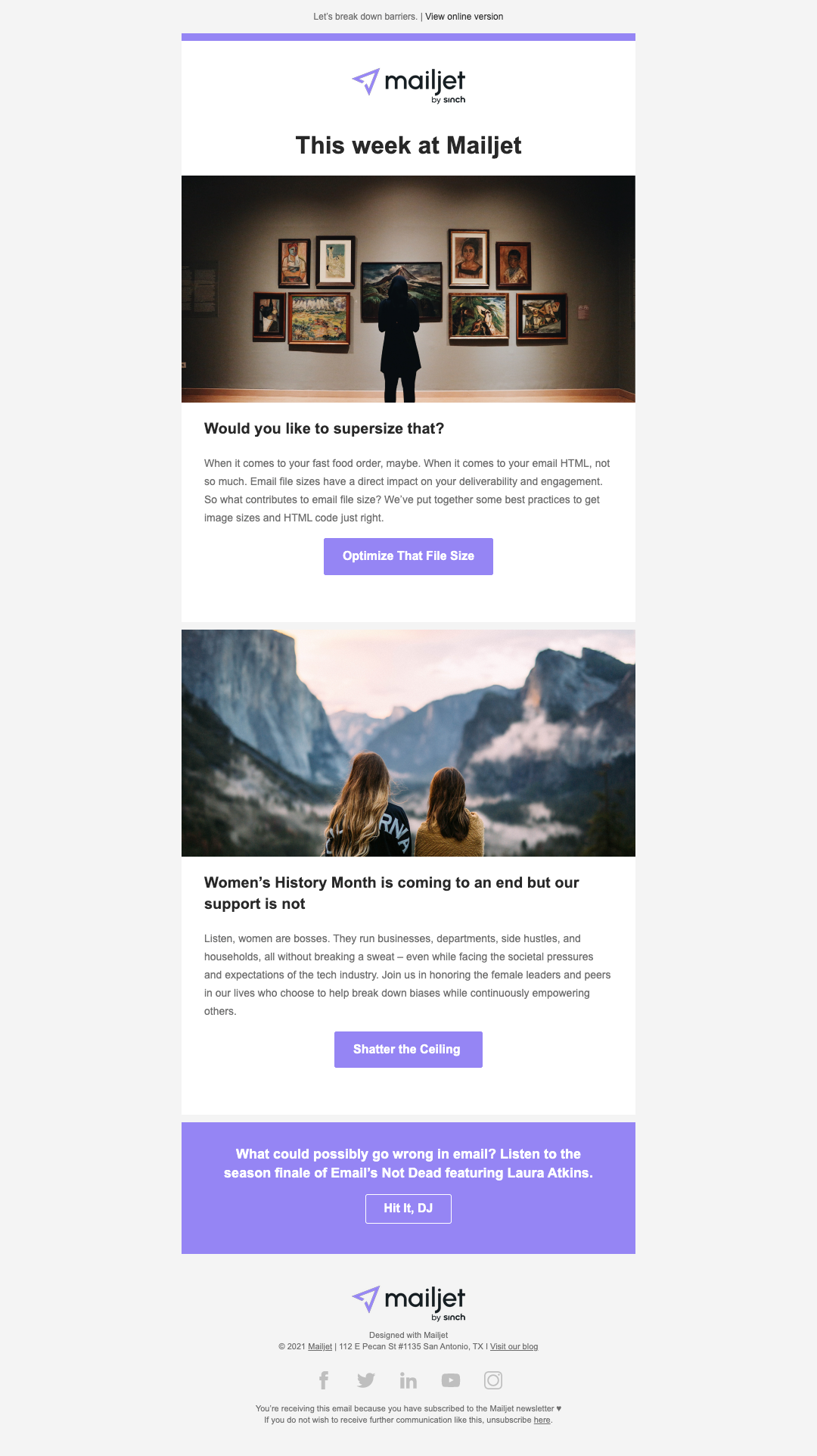
Sign up to Maijet’s weekly newsletter
Before you dedicate time and resources, it’s best to weigh up the pros and cons of newsletters so there are no surprises down the track.
The strengths and weaknesses of newsletters
The popularity of newsletters isn’t coincidental. Email marketing is one of the most effective marketing channels, with an average ROI of between $35-$40 for each $1 invested and 42% of customers stating they prefer to be reached via newsletters.
Well-designed newsletters guarantee constant website traffic that leads to conversions, including sales, product upgrades, webinar registrations, and more. As newsletters statistically form the largest part of all marketing emails sent, they hold a great deal of marketing potential.
Strength | Weakness |
|---|---|
Strength | |
Constant source of traffic | Absence of physical haptics |
Weakness | |
Considerable savings | Ease of deletion |
Easy performance measurement | List building takes time |
Independence from third parties | |
Easily linked to other marketing channels | |
Tailored customer communications | |
Reach people anywhere and anytime |
What’s more, email continues to be the preferred communication channel for customers. If you look at data from the new Sinch Mailjet report, The path to email engagement 2024, you’ll see that email in fact increased in popularity between 2021 to 2024, jumping from 42% to 75.4%.
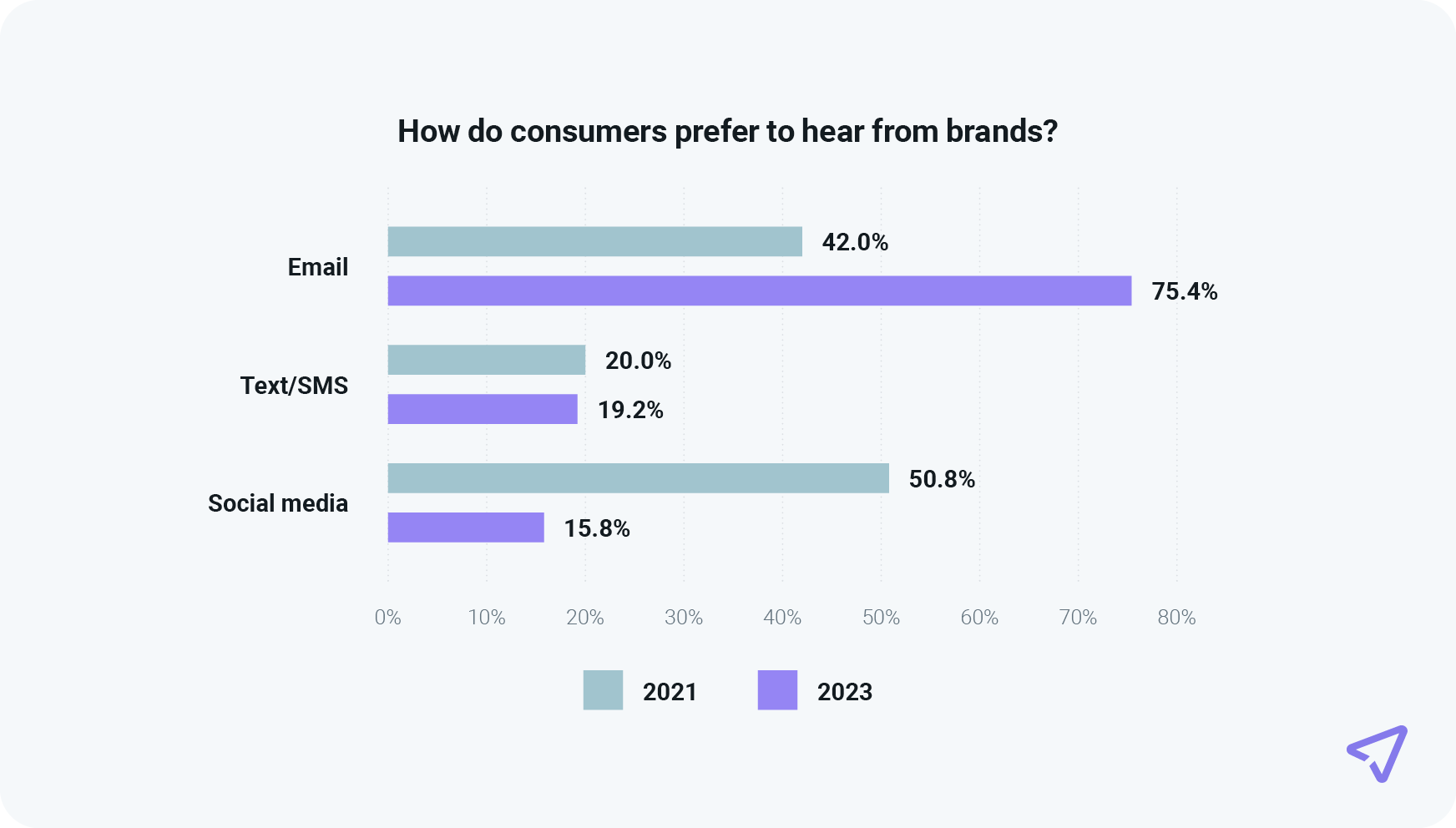
If one weighs up the benefits and drawbacks of newsletters, then it quickly becomes clear that the benefits by far outweigh the drawbacks. But let’s look at these in detail to better understand the pros and cons of newsletters as a key marketing channel.
Constant source of traffic
One of the main reasons for creating a newsletter is the regular website traffic that it generates. Organic engagement on social media platforms like Facebook and Instagram are declining dramatically. Banner advertising is rarely noticed in the era of ad blockers. Written press releases sent by email will often be ignored by journalists and online editors.
Luckily, this is not true for newsletters. Emails that reach someone’s inbox are usually seen, and the likelihood that they will be opened is relatively high, provided that the subject line is appealing, and the sender is recognized (as you will learn more about below). Well-designed newsletters containing relevant content will enhance your chances of the reader clicking on the call-to-actions for more information.
Considerable savings
Another factor that is not to be underestimated is how much money you save compared to other using other marketing tools. Paid advertisements like banner ads, Google AdWords, Facebook Ads, and influencer marketing are considerably more expensive than newsletter marketing.
The cost of newsletter software, known as an email service provider (ESP), is relatively low. Labor costs are also lower, as once the newsletter template is created, all that’s left is tailoring to each campaign and optimization. On top of that, most ESPs offer a free starter plan – for example, Sinch Mailjet currently offers 6,000 emails a month free of charge.
Easy performance measurement
A successful marketing tool is measured by its ability to support your business goals and KPIs. To know this, we need to keep track of key performance metrics. Compared to legacy media, email marketing performance is easy and accurate to measure.
Measuring the performance of a newsletter is simple – head to your ESP’s statistics dashboard for all your email marketing metrics like open rates, click rates, unsubscribe rates, bounces, etc. These KPIs will help you accurately calculate the return on investment (ROI) and produce targeted newsletter content.
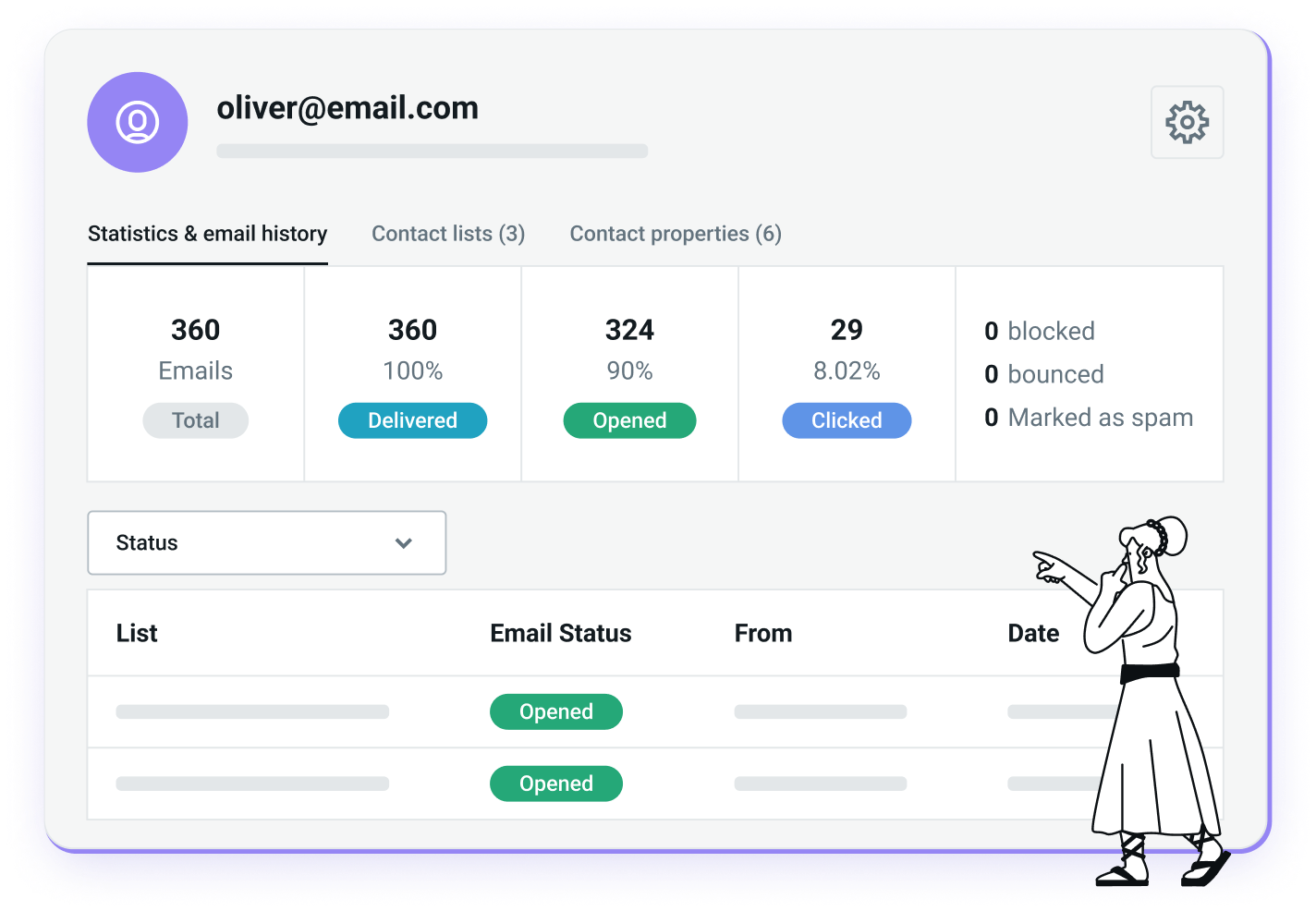
Independence from third parties
Publishers and influencers, as well as social media platforms and Google, are much more likely to increase ads cost as they control the access to their followers/users.
When you create a newsletter, you are independent of other service providers and software as you have control over your own database. Email service providers rarely increase the cost of its product, and even if they do, prices usually only increase by a small amount. With other marketing tools, increases are usually in the three, if not four-digit range.
Easily linked to other online marketing channels
Newsletters and other marketing tools such as social media boost your messages and build your contacts list and social followers. Most email builders have social media elements you can add to your header and footer. Vice versa, many social platforms have lead-generation tools to increase your email subscriber base.
Ability to reach people anywhere and anytime
Newsletters can reach recipients anywhere. Whether they are in the office, on their work computer, on the sofa at home on a tablet, or on the go on their smartphone, emails are opened and read anywhere. Our research shows that people check their emails multiple times a day, but of course, there are ways to be tactful with timing.
Tailored customer communications
It’s well understood that customers don’t just want, but expect a personalized marketing experience. In short, one size no longer fits all. Newsletters contain many opportunities to provide a tailored experience to users. The most common is using names in the subject line and body, but personalization becomes even more effective when you deliver more relevant content to your audience. This is achieved by segmenting your email lists based on their behavior or demographic and utilizing personalization tools from your email service provider.
Creating a newsletter has a number of advantages, from driving traffic to its low-cost margin, and integration with other platforms. But even if newsletters provide many benefits, they also have a few shortcomings.
Absence of physical presence
Now, onto a couple of the weaknesses of email newsletters. Unlike analog advertising media like brochures, flyers, magazines, etc., there is no haptic experience with email newsletters. For instance, a desk calendar is visibly looked at all year round or a business card may stay in your wallet for a while. Emails, on the other hand, do not have such a physical presence.
Ease of deletion
The fact that emails tend to be deleted quickly and read less intensively than other media cannot be denied. There are many reasons for this: a full inbox, unappealing subject lines, content that is not relevant, etc.
Although these inhibiting elements can be minimized, except for the first one, a 100% interaction rate can never be guaranteed. This is true not only for newsletters, but for all marketing tools.
List building takes time
Let’s face it – building a list takes time, energy, and patience. Contacts are the crux that power email newsletters and they cannot be bought. Other marketing channels are instantaneous as you pay-per-click (PPC), so the sky (or your budget) is the limit.
Fortunately, there are ways to speed up the list building process, and the end result is an engaged group of people who choose to hear from you regularly.
What makes a newsletter strategy successful?
Planning is key to the success of any newsletter campaign and should not be overlooked, so take the time to define your strategy. When planning a newsletter, it is important to be systematic and go through different stages. This can be challenging, but a well-thought-out newsletter strategy will pay off in the long run.
Step 1: Set out your goals
The first step in developing your newsletter strategy should always be defining your goals. It can be helpful to review your business goals, visions, and values before you start. This will give you a good overview of your company and its main aims, which your newsletter should also be working towards.
To identify the aims of your newsletter strategy, you should consider why you want to create the campaign. The more clarity you have on the reasons for making a newsletter, the more successful you will be. Ask yourself the following questions:
What do you want to achieve?
Do you want to make potential and existing customers aware of new blog posts, special events, or products?
Or is it more about winning new customers and strengthening bonds with existing customers?
The goals you should focus on will depend on your company, as objectives can vary greatly across different industries and organizations.
Step 2: Develop your KPIs
Choosing your key performance indicators (KPIs) is extremely important when planning your newsletter. KPIs are key stats or metrics that help you to measure the success of your email marketing campaign and your overall strategy. Metrics reflect how well your email marketing is performing and highlight areas where you need to make changes.
KPIs include:
Open rate
Delivery rate
Unsubscribe rate
Click-through rate
Bounce rate
Spam rate
Conversion rate
Remember that KPIs will depend on the goals you have previously set. You should identify and evaluate KPIs that are crucial for achieving your goals. This allows you to analyze and evaluate your campaigns and objectively determine their success or failure, which will ensure you’re ready to adapt your strategy at any time.
Company goal | Objective | KPI | Target value |
|---|---|---|---|
Company goal | |||
Sales of product X | More sales via newsletter | Conversion rate | $2,500 a month |
Objective | |||
More unique website visitors | Click-through rate | 5,000 unique visitors per month | |
KPI | |||
Increase gross profit | Margin | 20% | |
Target value | |||
More effective marketing | More newsletter subscriptions | Subscriptions | 250 sign ups a week |
Meet customer desires | Open rate | 40% | |
Provide in-demand products | Click-through rate | 20% |
Step 3: Find the optimal sending time
When planning, you should consider the best time to send out your marketing email. The time at which you send out your newsletter is critical for its success. It is vital that you reach your recipients when they are likely to be not only checking emails but also able to engage with them. But how do you find out what the best times are?
As a starting point, it’s worth checking out Sinch Mailjet’s research into the best time to send newsletters. But to really understand your audience, you need to analyze your target group and carry out various tests. Try sending out your newsletter at different times to identify when your email open rates are at their highest and, therefore, when the majority of recipients read your emails.
You can also use analysis tools like Google Analytics that show when your target group is most active on your website. You can use this knowledge to send out your campaign at the time when they are active.

Google Analytics can generate heat maps of when your users are most active.
Step 4: Create newsletter content strategy
The content of your newsletter is essential to achieving your goals. Setting up a content marketing strategy ensures that your content provides value to the reader. So, your newsletter content should ensure that your goals are met and motivate your target group to perform certain actions.
Consider what piece of content is most appropriate for your strategy and audience. If you’re struggling with potential topics, then we recommend taking a closer look at your competitors’ newsletters and other successful examples. This is a good opportunity to find inspiration and ideas for potential content areas.
Another method that can work well is a preliminary survey. Eliminate the guesswork by simply asking your target audience what content they want to be featured in your newsletter. A target group survey will steer your content strategy in the right direction. You can incentivize people to take part by offering a freebie giveaway.
Step 5: Choose your newsletter software
Before you can get to work, you need professional newsletter software or ESP to create, send out, and evaluate your email campaigns.
There are plenty of free ways to create and send your newsletter. Gmail, for example, allows you to send emails directly from your company domain. That said, we advise against using mailbox providers, as they come with limited tools, sending limits, and tricky mail merge configurations. Worst of all, you can’t set up email authentication, so you might be identified as a phisher and sent straight to the spam folder.
Therefore, you need to choose a purpose-built ESP that’s easy to set up, comes equipped with a suite of useful tools, and has a dedicated support team on hand. Of course, there are many email service providers out there on the market and choosing the right one is not easy. We really are spoiled for choice!
First, think about what features you need to successfully implement your newsletter strategy and what services you value most. You can get a good feel for this by making a list and then comparing the various newsletter tools against one another.
To make your life a little easier, we’ve put together a list of functionality that any professional email service should offer:
A drag-and-drop email editor to create newsletters in minutes
A selection of pre-made, customizable, and responsive newsletter templates
Personalization, for the creation of targeted email content
Email segmentation options to divide up contact lists based on demographics or behavior
Integrated image editing for easy image enhancements and adjustments
Responsive subscription widget to build legally compliant newsletter subscriber lists
Intelligent contact management for efficiently dealing with contacts’ data
Optimal deliverability to ensure emails reach inboxes
A/B testing, to safely try out new ideas in your campaigns
Detailed statistics, so you can analyze and optimize your sent newsletters
A free trial, so you can verify that the newsletter software meets all of your needs
Integrations with other systems and services, such as WordPress, Salesforce, etc.
GDPR compliance and other certifications
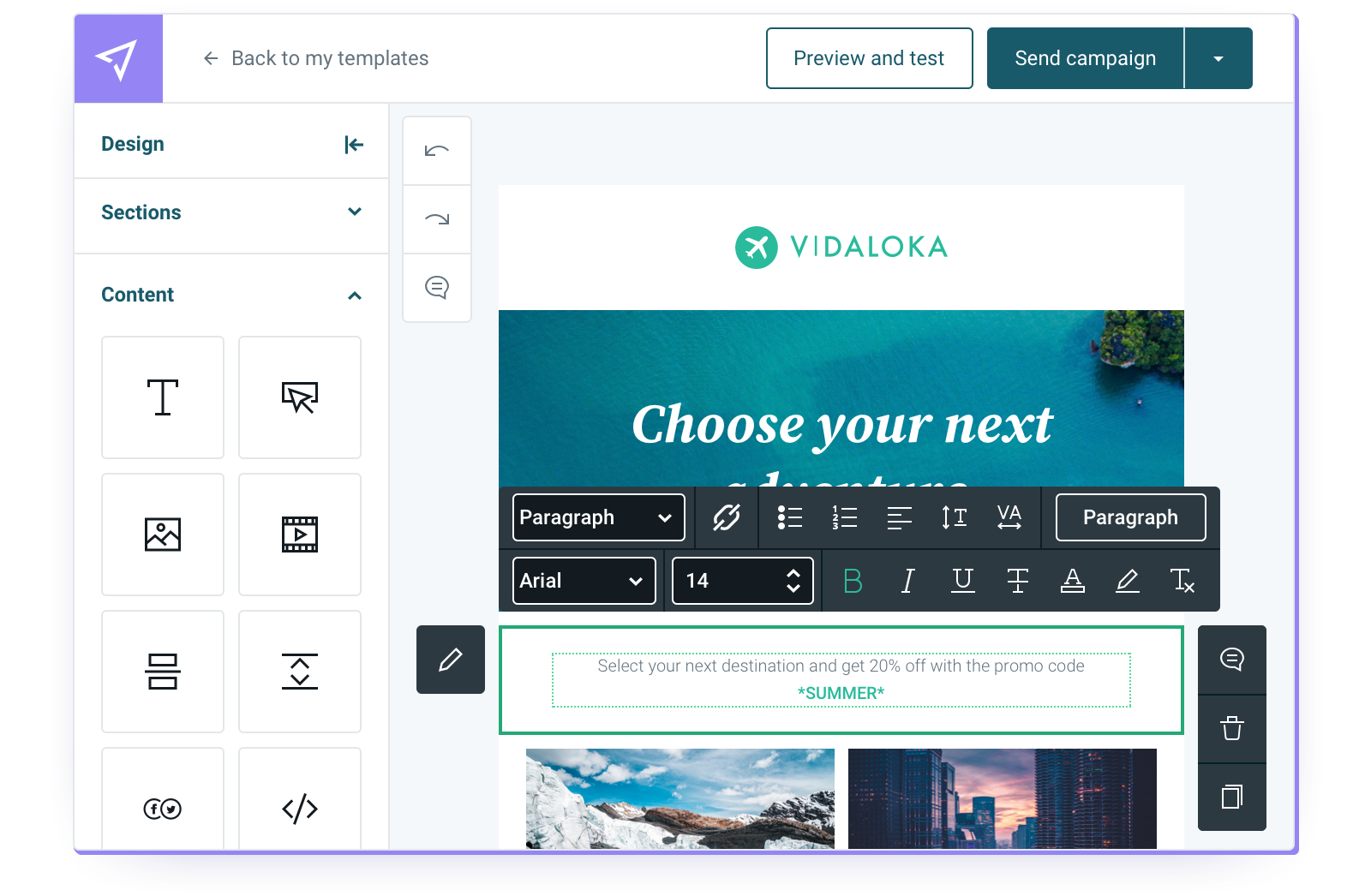
Step 6: Build a contact list
Before you can finally hit send on your campaigns, you need email recipients. Building a high quality contact list is often considered a challenge, but as long as you patiently carry out these growth hacks, your list will grow in time. But remember – always strive for quality, not quantity.
Stay away from bought lists
This is fundamental: resist the temptation of buying email lists. Purchased lists contain email recipients who have probably never been in contact with you, don�’t know your company at all, and don’t want to receive your emails. This makes the risk of your newsletter being blocked and ending up in the spam folder very high. The damage is significant as your deliverability and reputation with inbox providers like Gmail will suffer.
Win new subscribers with a responsive signup widget
When building your email list, use a responsive signup widget connected to a double opt-in form. Double opt-in ensures that no fake email addresses enter your database and damage your reputation and email deliverability. This minimizes the risk of being classified as a spammer by your recipients or their ISPs.

Mailjet’s subscription widget builder
Add the signup form to different pages on your website, like your home page, blog, resources pages, etc.
There’s a reason why zero-party data made its way on to this year’s email trends list. People are increasingly suspicious of how their personal information is being shared between companies. So there’s a thin line between asking for key info and scaring potential subscribers away with long signup forms.
Always highlight the incentives of signing up and show your users what great added value your newsletter offers them.
Divide your email recipients into smaller segments and tailor content to each segment to really deliver on that value you promised at signup.
Use landing pages as newsletter lead generation
As well as a responsive subscription widget, you can create special newsletter landing pages in order to grow your contact list. The advantage of a landing page is that you can focus the reader on the newsletter subscription call-to-action.
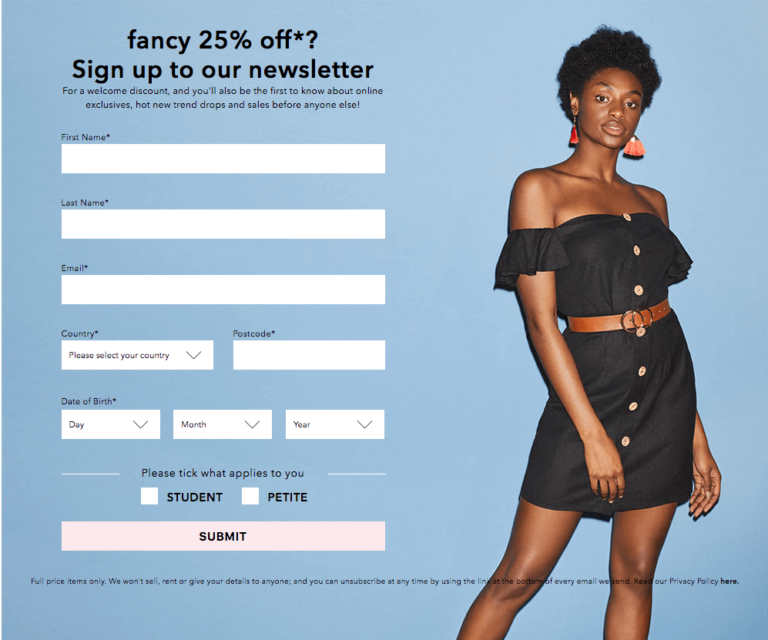
Users visiting your newsletter landing page will not be distracted by any other elements on the website, as the entire focus of the page will only be on subscribing to your marketing communications. This is the best opportunity to present all of the advantages your newsletter offers to your customers.
For increased efficiency look for an email marketing software platform with a built-in landing page tool. Not only will the email editor be familiar to your team, it guarantees a consistent experience for readers while allowing you to accurately performance from a single platform.
Make it clear what your potential recipient will be missing out on if they do not subscribe. Ideally, you will already have defined this in your newsletter strategy. Some of the advantages of subscribing to a newsletter might include:
Advantages of subscribing to a newsletter might include:
Exclusive offers, coupons, and content
Important updates
Latest industry news
Personalized advice and roundups
Early access to events and product releases
Granting access to exclusive content upon registration – such as a step-by-step guide or a discount – will significantly increase your subscription rate.
All right – enough planning already! Let’s look at how to create and send your newsletter.
Step 7: Creating a newsletter
A newsletter is formed by the following three components: design, content, and legal information. Let’s explore these in further detail.
Newsletter design – the first impact
The first step to creating a newsletter is choosing a corresponding email template. The quickest way is to use a template provided by your email service provider and customize each element.

Sinch Mailjet has a library of responsive templates to choose from.
Alternatively, you can upload a newsletter template you have already created or sourced from a third party. In this case, make sure that the selected layout is responsive so that your email campaigns will be perfectly displayed on every device.
Our advice: Don’t use several columns in your newsletter. As many recipients will initially see incoming emails in preview mode, the ideal width of a newsletter is between 500 and 680 px.
When it comes to email design, there are some solid guidelines to follow. A clear structure ensures that subscribers grasp the content and core message(s) immediately. The following layout is proven to work for classic newsletters promoting new content. Insert your company logo in the upper section so that the readers immediately associate the newsletter with your brand. Add images to attract the readers’ attention, followed by some brief text and a clear call –to action.
Here are some quick-fire design tips:
Newsletter colors should correspond to the primary and secondary colors in your brand kit. Combine these colors with plenty of white space for clarity and professionalism.
Clearly separate the header, main body, and footer of your newsletter from each other.
Where appropriate, use images or color contrasts to visually separate sections or highlight CTAs.
In order to avoid erroneous clicks, ensure that the embedded links have sufficient space between them.
Find a Google font and fallback font and ensure the body text size is between 16-18px with titles no bigger than 26px.
We have all these design tips and more in our baking-themed infographic, The ultimate newsletter design recipe. Check it out and be sure to create a chef’s kiss-worthy newsletter template for your company!
Choosing a sender name
The average email user receives anywhere between 0-50 emails every day. In order for your newsletter to be noticed by your subscribers, bring some attention to your sender name.
We recommend using your name followed by the brand. For example, when subscribers see newsletters from “Julia at Mailjet” in their inbox, they know to expect fun conversational wording and useful content.

Formulating an email subject line
After the sender’s name has been chosen (and it should stay the same for all future newsletters), the subject line should be defined. Along with the sender’s name, the subject line determines whether or not your newsletter will be opened.
While the subject line should match your brand voice, this is a chance to stretch the tone of voice a bit further. And fortune favors the bold, so don’t be afraid to try out something new.
Amusing text, questions, citing the recipient’s name, or even emojis all jazz up the subject line and draw attention to your newsletter. As you are probably very reluctant to be labeled as a spammer, avoid the use of deceiving spam words like “free”, “urgent”, or “congratulations.
Writing the heading
The heading is the third text element that you customize. In the above example, the heading says, “Remember these dates.” Together with the subject line, it summarizes the email content and motivates the recipient to pay attention to your newsletter, often with curiosity.
Creating newsletter content
Okay so you’ve convinced readers to open your email, you’re now on borrowed time. Everything you do at this point must respect the reader’s urgency. After all, they have other emails to sort through.
They say content is king because no matter how well you present your email, if the content stinks, you’re going to the trash or worse – unsubscribed. So make sure your content strategy is airtight before you start rolling out a regular newsletter, or you’ll be scraping the barrel for content ideas come newsletter day.
Possible content may include:
Promoting the latest blog articles
New freebies like podcasts, guides, white papers, studies, etc
Invitations to seminars, webinars, and other events
Early access to new product launches or events
Excerpts from long-form media
Messages from business leaders or influences
Personalized content recommendations
The following rule applies: An email usually has one key message. But newsletters are the exception. By offering multiple stories, you have more chances of hooking the reader. However, make sure not to advertise too much content in one email. Too many CTAs will overwhelm the reader, so you’re better off having a shorter but more frequent newsletter cadence.
Place your most important information at the beginning or near the beginning. The more subscribers have to scroll down, the higher the likelihood that content further down will not receive any attention.
Images enhance newsletters in many ways, but beware! Too many visuals impact negatively on the deliverability rate as this is a favored tactic of spammers. ISPs know this well and often block emails containing large image components. So, you should aim to strike a balance between text and graphics. We recommend a text-to-image ratio of 70:30 in favor of text.
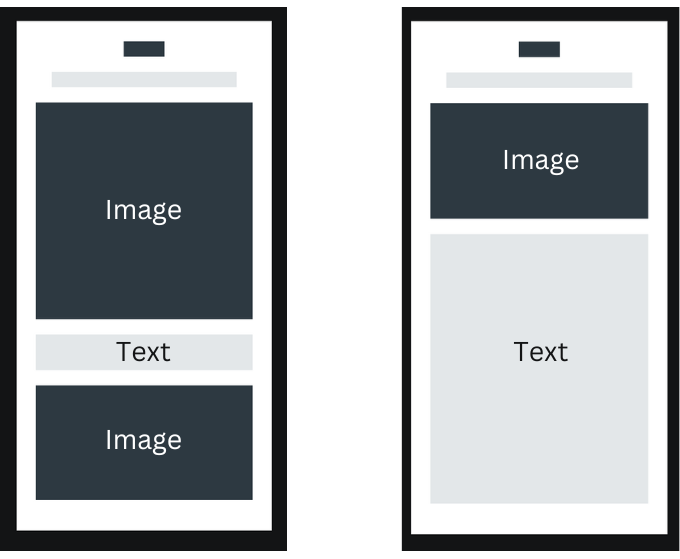
Inbox providers prefer the image-to-text ratio seen on the right.
When you create your newsletter, don’t forget to add alt text to the images for visually impaired users. Email accessibility is becoming a hot topic in email, so you don’t want to be left behind. Not only that, but some email clients block images so that subscribers just see a large white area.
Legal requirements
Those who send newsletters must adhere to certain legal guidelines.
By law, you must include:
An unsubscribe link that is clearly visible. It’s standard to have an opt-out link somewhere in the footer.
A physical address must be provided. This is also traditionally found in the footer.
Consent must be given before sending any marketing materials, using a subscription form or checkbox upon creating a new account.
Use newsletter software that is compliant with General Data Protection Regulation (GDPR).
Ensure you adhere to the legal requirements mentioned above to avoid legal disputes, warnings, and expensive financial penalties.
Step 8: Sending your newsletter
Once you have created your newsletter, you need to test whether it’s displayed correctly on different screens. Most ESPs allow you to preview your email on a simulated desktop, tablet, and mobile device.
But if you really want to safely hit send, you’ll need to test your newsletter on a real email client. There are two ways of doing this, you can either send a test email to yourself and open the email on multiple devices. Alternatively, you can save time by using email testing software like Mailjet’s Email Preview which tests your email on multiple devices and operating systems in-app.
Step 9: Analyzing and optimizing newsletters
Congrats on building and sending your newsletter, each edition gets easier as you replicate the process. However, to be successful in the long term, you need to analyze the performance of your newsletter thoroughly. This helps identify your strengths and potential weaknesses and optimize your emails. So, we’ve gone full circle back to our KPIs.
Track the following metrics for newsletter analysis:
Open rate: The percentage of subscribers who opened the newsletter.
Click-through rate (CTR): The percentage of recipients who clicked on at least one link (CTA).
Conversions rate: The percentage of readers who have executed the desired action after clicking a CTA (purchase, download, view product page, etc.).
Unsubscribed: Keep a close eye on this metric as it determines if subscribers are finding value in the newsletters you send out.
Deliverability: This is the effectiveness of getting your email past ISP filters and into the inbox. This includes carefully reviewing your delivered, blocked, spam, soft and hard bounced, and queued emails.
Use this data to determine the exact performance of your newsletter and make any adjustments to individual elements. We recommend always implementing these adjustments using A/B testing.
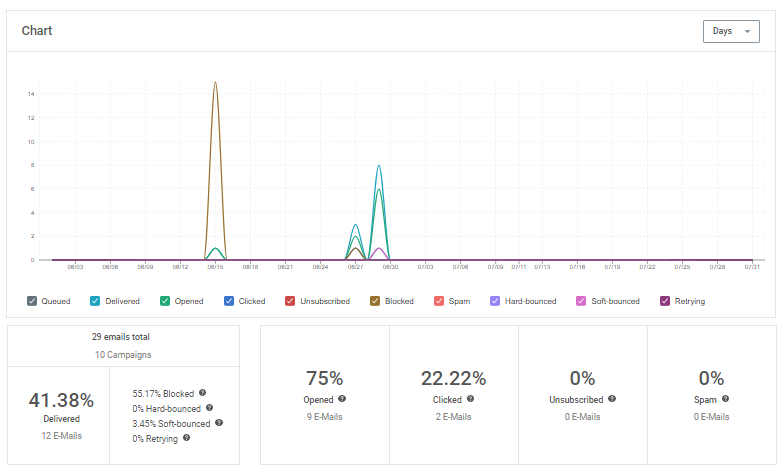
Sinch Mailjet’s reporting dashboard
Use this data to determine the exact performance of your newsletter and make any adjustments to individual elements. We recommend always experimenting with new ideas with an A/B testing tool.
In conclusion
Newsletters have stood the test of time as they serve as a direct link between companies and customers. Yet with GDPR, increasing privacy concerns, and more sophisticated tools from ISPS, it has never been more important to plan an effective newsletter strategy.
With the marketing tips we’ve covered here today, you can perfect your email marketing strategy and create some of the most valuable newsletters in your field.
Want to know more about how to plan an effective email strategy? Check out our Email Growth Playbook, a database of 60+ tactics to help you increase the performance of your email campaigns.
Start sending your newsletters with Mailjet
Mailjet provides a completely free newsletter platform covering every step of the process – from beautiful ready-to-use email templates, a drag-and-drop Email Editor, and flawless sending and analysis. Just create your content and let us take care of getting it to the inbox.








